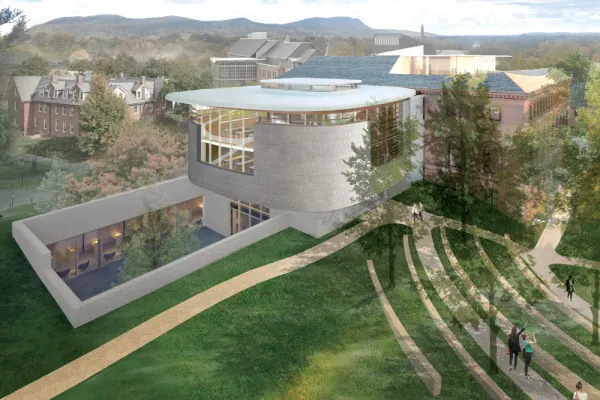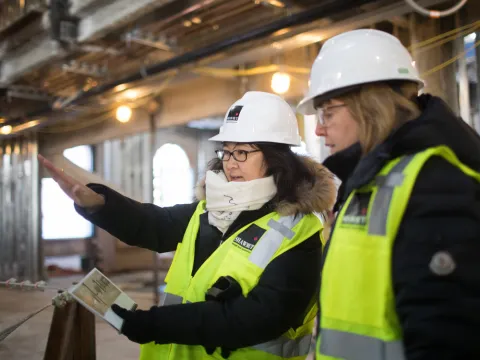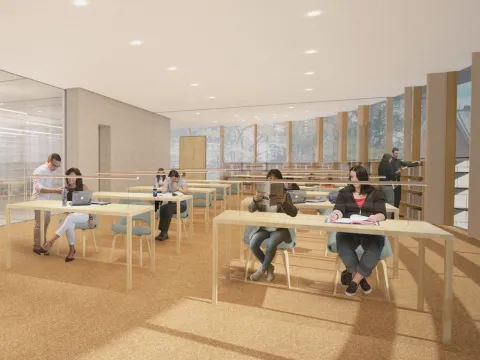Read All About It: Neilson Library’s Sustainable Future
Sustainability

Published March 25, 2020
When the new Neilson Library officially opens in spring 2021—after a three-year, top-to-bottom renovation—it will be among the most energy-efficient buildings on campus (and perhaps in North America), according to Dano Weisbord, executive director of sustainability and campus planning.
That has been the goal all along. Maya Lin, the architectural designer overseeing the project, envisioned a structure that was one with its surroundings, that used natural materials and was guided by sustainable design principles. “My approach,” Lin said in fall 2016 when she unveiled her design, “is to create a new, state-of-the-art, sustainable building that creates a dialogue with the historic Neilson and opens up and restores the Olmsted [landscape] master plan, expanding the possibilities of the library while reducing the overall footprint of the building and restoring the heart of the campus.”

President Kathleen McCartney reinforced Lin’s vision, saying, “We are committed to making Neilson one of the highest-performing libraries in North America, a place that reflects not only Smith’s commitment to teaching, learning and research, but also to sustainability.”
Here’s how the new Neilson Library prioritizes sustainability and contributes to Smith’s transition to a zero-carbon campus.
A BETTER, NOT BIGGER, LIBRARY
Before its renovation, Neilson was the largest building on campus, accounting for about 6 percent of the college’s indoor space. Once completed later this year, the new Neilson’s interior will be 25 percent smaller than the original structure, decreasing it from about 200,000 square feet to approximately 150,000 square feet. Consequently, far less energy will be required for heating and cooling.
A HEALTHY BUILDING
Throughout the construction process, contractors have been adhering to the “healthy materials initiative” to ensure good indoor air quality. They’re doing that by minimizing materials that are on the Living Building Challenge’s “Red List.” This means that flooring, paint, insulation, ceiling tiles and other materials do not contain common toxins that have been shown to cause harm to human health and the environment. Lin’s design also prioritizes the use of natural materials, including wood and stone.

AIRTIGHT ARCHIVES
The new Neilson will preserve the college’s important collections while also preserving the environment. “To have an energy-efficient building that includes archival storage is a big deal,” Weisbord said. Here’s why: The old building had just one set of conditions—a consistent temperature of about 70 degrees and varying levels of humidity. In the new Neilson, temperature and humidity levels can be adjusted accordingly to create optimal conditions based not only on space but also on the materials within that space. This is particularly important for Special Collections, which will occupy the core of the new Neilson’s south “jewel box.” “That entire core will be a glassed-in box inside of the building,” Weisbord said. “Inside the innermost box, the conditions are optimized not for people but for paper. So, it will be 62 degrees and 50 percent humidity pretty much all the time, with little variance.” Taking this box-within-a-box approach is one way to significantly reduce energy use. According to Weisbord, the building will be “smart” enough to “pull in fresh air from the outside, condition it for the people spaces first and then further condition it for the archival materials.” The intent, Weisbord said, is to make Neilson the most energy-efficient library with archival storage in North America.
FLEXIBILITY FOR THE FUTURE
The renovated building’s heating and cooling system is designed to be fully compatible with Smith’s design for a future campus, with a fossil fuel–free energy system. That’s important, especially as Smith moves forward with its plans to significantly reduce its carbon emissions footprint by changing how it distributes heat throughout the campus’ 114 buildings. Currently, heating, cooling and powering the campus accounts for 90 percent of Smith’s greenhouse gas emissions. The goal, Weisbord noted, is to get to an “electric campus” that uses electricity generated by renewable power, including wind and solar. Neilson Library, with its 21st-century design and sustainable approach, will be ready to accommodate the upgrades to come in the next decade.
This story appears in the Spring 2020 issue of the Smith Alumnae Quarterly.
SMITH ALUMNAE QUARTERLY
Special Climate Issue

Mission: HEALTHY EARTH
How the Smith community is fighting to save our planet
Energy efficiency is being built into the new Neilson Library, with special effort going into the south “jewel box” that holds Special Collections.